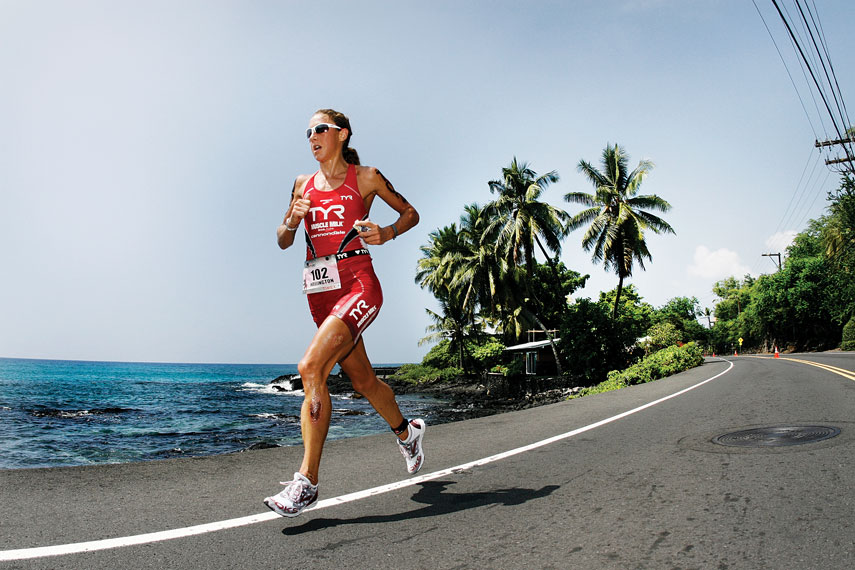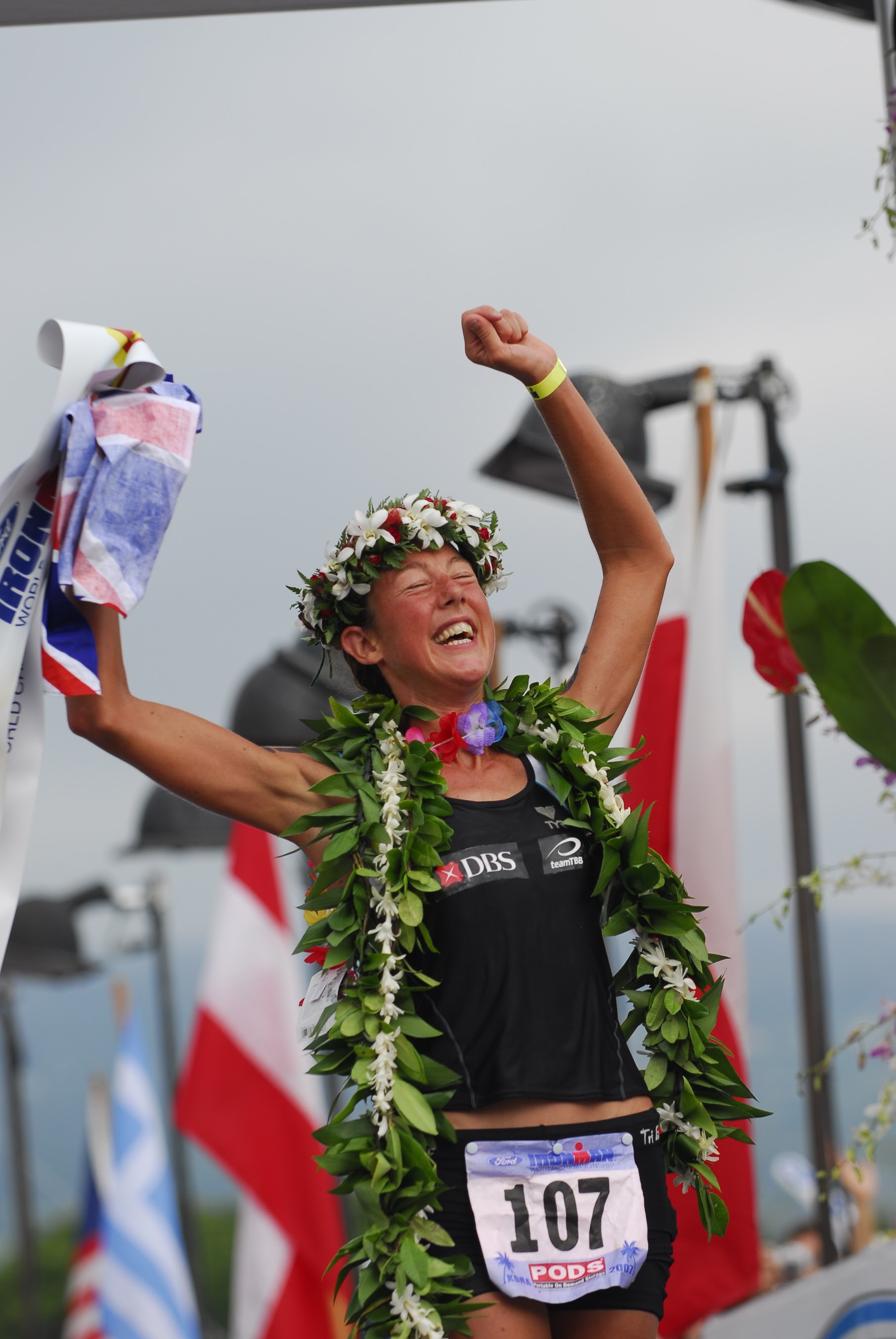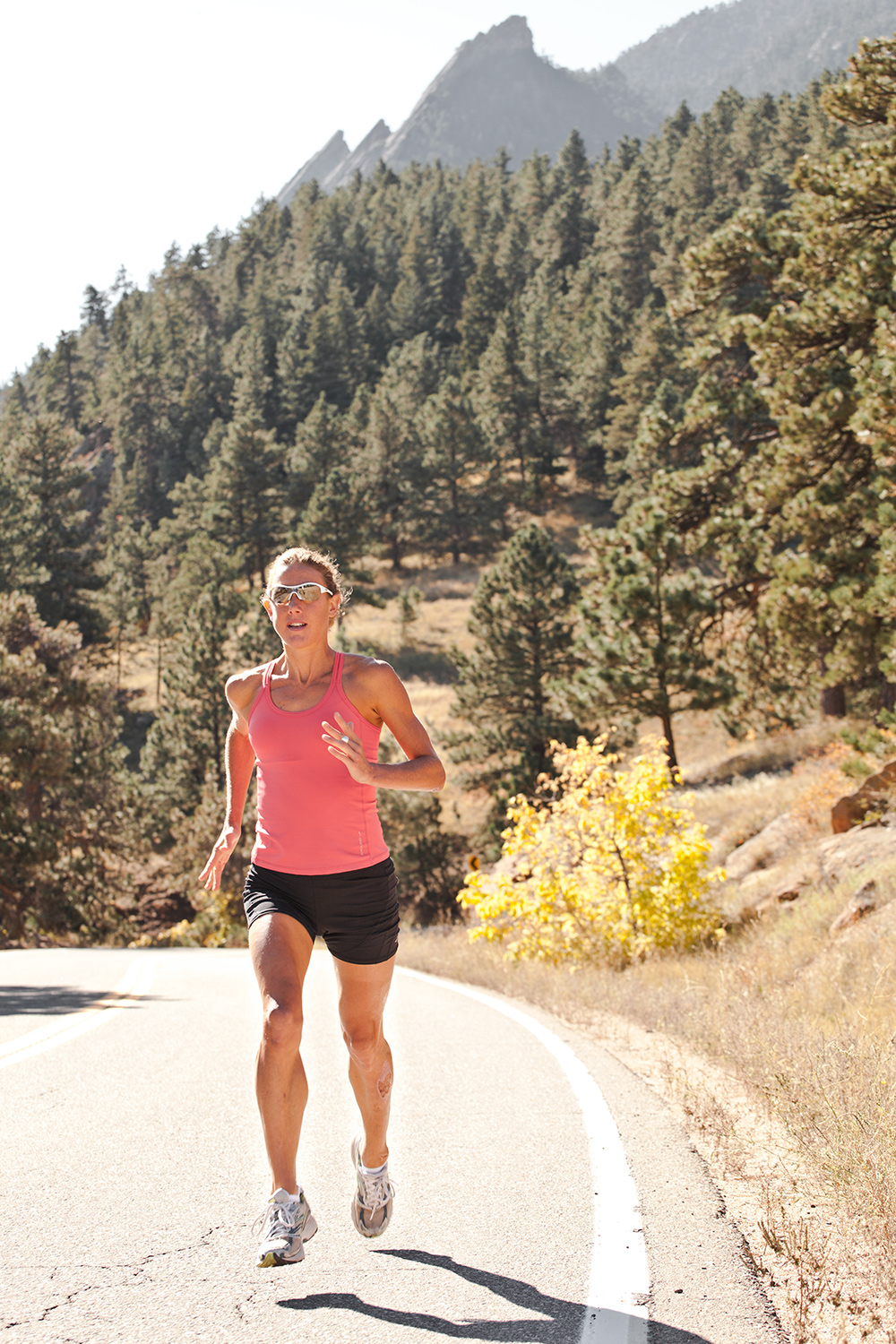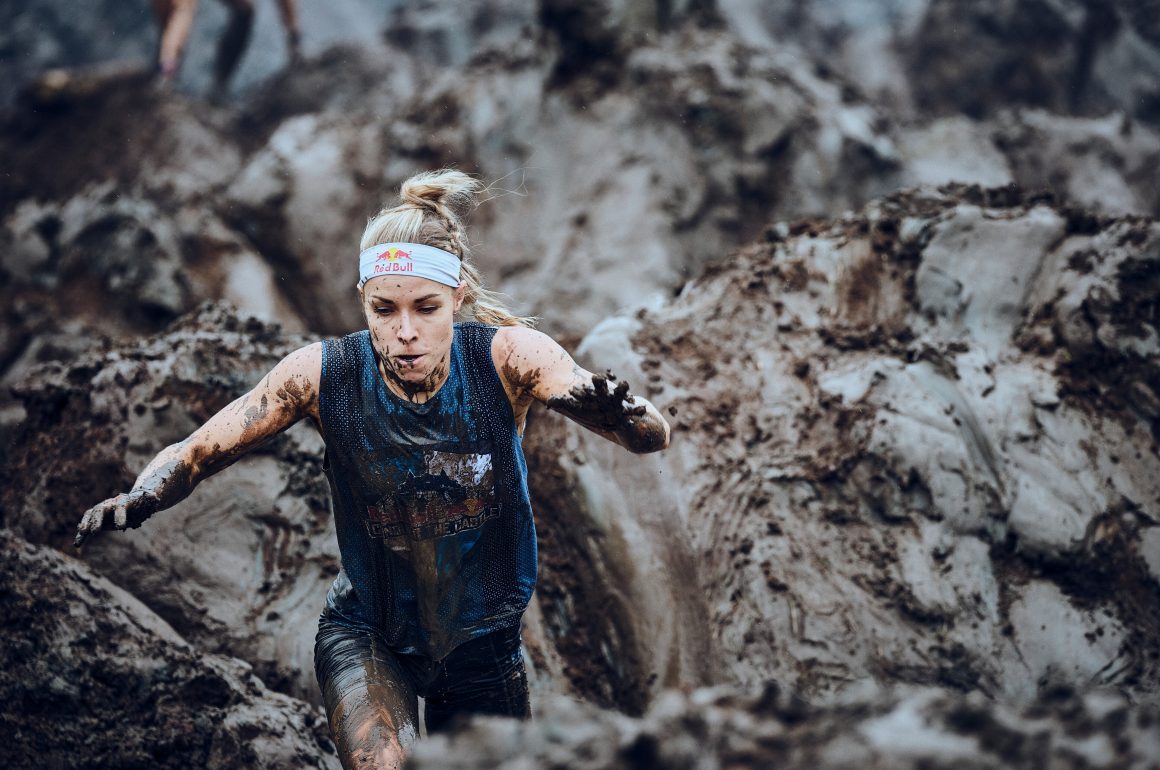
Photo Credit: Larry Maurer
A four-time Ironman World Champion, Chrissie Wellington did the unimaginable in 2007 when she won the Ironman World Championship in her rookie professional year. Unbeaten in every one of her 13 Ironman races (!), she took triathlon by storm and broke her own course records numerous times before retiring from professional triathlon in 2012.
I’m massively excited to have Chrissie on Lessons in Badassery and very grateful that she took time out of her crazy book launch schedule to answer my questions. To the Finish Line, her new book, launched yesterday and is a go-to guide for everything you need to know about triathlon – from goal-setting to race prep, amongst candid accounts of Chrissie’s own experiences, nutrition plan, training schedule and favourite drills. I had a read of it over the summer and it’s brilliant.
I put some questions to Chrissie, covering everything from mental strategies to her thoughts on La Course, the women’s Tour de France event she campaigned to bring about.

Chrissie, your new book, To the Finish Line, contains a wealth of personal triathlon experience and wisdom, and even includes examples of your training and favourite drills. Can you tell us a bit about it?
It was a totally different experience to writing my autobiography [A Life Without Limits – published in 2012], but no less enjoyable and challenging. I wrote my first book while I was still a professional athlete and the process was extremely cathartic, and quite challenging emotionally as I divulged details of my personal life that I hadn’t really shared before.
My latest book, To the Finish Line, came from a realisation that the autobiography left many questions unanswered, especially around the specifics of training and racing. So I set about creating a more detailed, structured guide, but one that was accessible and readable – not a dry, dull technical manual. It covers an array of subjects – everything from setting goals, nutrition, training for swim, bike and run, race strategies, strengthening your mind, coping with eating disorders, and exercising when pregnant. In many respects it contains lessons that transcend sport, and can be applied to all areas of life. You definitely don’t have to be a triathlete – or even an athlete – to benefit.
Like my autobiography, I hoped that by drawing on my own experiences, and sharing aspects of my training that I have never disclosed before, I could bring the subject to life. I really enjoyed writing it, and working with a few of my closest advisors and mentors on certain subjects has hopefully added a bigger splash of colour.
In terms of the process itself, the bulk of this latest book was written after giving birth to our daughter, and so it involved a lot of late nights and a very understanding husband – a true labour of family love!
This year you ran the 52.6-mile Heineken Race to the Tower ultra event, coming first lady and 2nd overall. How did you find the race, and will we see you competing in more ultras?
Doing an ultra definitely pushed me out of my comfort zone – I was worried I might not even finish – but that fear is a good thing and as an athlete I like to be pushed out of my comfort zone. I’ve already done my second ultra, the off-road, hilly 30-miler, Mendip Marauder, from Wells to Weston Super Mare in Somerset, which was a wonderful, low-key local race and took in a lot of the places I know well, having done a lot of cycling around there. I’m sure there will be many more ultras in my future!

As for the HEINEKEN Race to the Tower event, some of my friends had enjoyed the Race to the Stones events, so in a moment of post-marathon delirium I decided to sign up, despite saying I would never do one. The longest run I’d done prior to that was a marathon, so contrary to a lot of people’s perceptions of my fitness, this was always going to be a massive challenge for me. However, the run event itself had an incredibly relaxed atmosphere and rawness to it that I loved. It was about enjoying the journey, forgetting running to pace – I walked up the steep hills – and just doing my hardest to finish.
How did you fuel the Race to the Tower event?
I ate porridge with tahini mixed in and honey on top for breakfast, and then during the race I had 33 Shake gels, some energy drink, water and peanut butter and a few handfuls of Jelly Babies at some of the aid stations. It didn’t differ significantly from my ironman nutrition, in that I tried to take on about 60-70g of carbs an hour. In an Ironman race, on the bike I would have two bottles of sports drink, with about 350 calories in each, plus water, two energy gels (one at 90km and one at 140km) and a chocolate bar which I had a bite of every hour. On the marathon, I’d have a gel every 25 minutes, washed down with water – and maybe some flat coke at around 35km or so.
What does a typical week of training look like these days compared to your pro days?
Back in 2011 I devoted 5 years to being the best athlete I could be. Since retirement I’ve had to mentally and physically move on and distance myself a little bit from the athlete that I was. I was training for 4-6 hours a day and racing for 8 or 9 hours was second nature, but life is different now. My husband, Tom, and I have a wonderful – and very energetic! – daughter and a job, a social life… lots of balls to juggle. I do try to run for an hour a day, sometimes for up to 90 minutes, once a week, but have to be more flexible and also accept that I can’t always control everything like I used to – sleep, nutrition, strength work etc. That’s not to say I can’t have goals, and focus on them, but I also have to accept that if I want to have balance, it also means modifying the goals to fit in with the other priorities in life.
What are your favourite pieces of kit for racing and training?
My Brooks running shoes, my iPod shuffle – when I’m training – a good sports bra and a decent pair of running socks!

You’re a self-confessed ‘Back-to-basics’ athlete. Do you think we’re all a bit tech-obsessed?
We’re bombarded with gadgets! Heart rate monitors, GPS, cadence counters… we can analyse and record nearly every aspect of training, which can be both confusing and expensive. So yes, as you said, I’m generally a ‘back to basics’ person and have trained by feel – or by breath, as it was when I used to bike whilst living in Nepal!
When I was competing, I did use a clock at the poolside to pace/guide my swim, and a GPS watch/treadmill to pace my runs, but I like to keep it simple. My advice: use gadgets as part of your training but don’t become a slave to the technology or the number, and remember that nothing is more important than training the computer you have between your ears – the brain – which is your most powerful weapon of all.
When you were competing did you have any mental strategies for when the going got tough?
In every Ironman I’ve done, I’ve wanted to quit. That little voice in one ear that says ‘pull to the side, it’s not going to be your day’. But I’ve pushed through, repeating my mantra ‘never ever give up’, playing songs in my head, counting repetitively in time with my pedal stroke or footsteps, breaking the race down mentally into manageable segments, and ultimately recalling all the times I’ve overcome discomfort in the past. You are only as powerful as your mind – and mental strength is just as important as physical strength in sport.
During races I have used positive affirmations, recalled my favourite Rudyard Kipling poem, ‘If’, in my head, and I write on my wristband and water bottle my personal mantra, ‘Never give up, and smile’, which I’ll glance at occasionally.
It was vital that I developed these strategies long before race day and taught myself how to cope with pain and discomfort in training. It’s in training that we can condition ourselves to endure, and develop the strategies for overcoming self-doubt and discomfort. Set yourself goals in training that you may not think are possible; test yourself periodically to go beyond your conceived limits and bank those memories and experiences to give you confidence that come race day you can do the same.

You campaigned for there to be a women’s Tour de France. What did you think of this year’s La Course event?
I was really excited about La Course this year, and love the progress they have made with promoting it on social media, increasing the profiling of the riders and explaining the format of the event. It certainly helped to engage more people, and build the interest and excitement. Yes, the races on the Champs Elysees over the past few years were iconic, and gave La Course the initial platform, but it’s also important that the sport continues to try new things, to evolve and to innovate and hopefully this innovation will increase the interest in women’s cycling, and showcase the varied strengths and depth within the peloton.
I certainly enjoyed the new format, especially the first day, mountain top finish and I think the viewing figures showed that the general public did too. I hope that this year’s event is another springboard to a race with more stages over the next few years; so that La Course can continue to put its stamp on the racing map, and catalyse change elsewhere – in other races, in commercial sponsorship, in the public interest and demand and in media coverage. I’m really proud to have played a small part in bringing La Course to fruition, and really want to see it – and women’s cycling – go from strength to strength.
As we head towards winter training, have you any tips for avoiding boredom or lapses in motivation?
Like everyone else, I have motivational off-days. Although people assume my motivation is limitless and that I never have an off-day, this couldn’t be further than the truth. So my tips: Remember your goal, and that getting out in the rain to do a run, for example, is a step closer to that goal. Make training as convenient as possible. Find a gym, run track, pool that is accessible and financially affordable; keep your running clothes at the office so you can do a quick session in your lunch hour. If you’re exercising outside make sure you dress for the weather conditions to make colder and wetter autumnal weather more bearable.

If you like music, use it – although I’d avoid this when cycling outside – or perhaps download motivational training podcasts; my AudioFuel training sessions are really quite good! Get a reliable training partner who can motivate you and hold you accountable, or join a group if you prefer training with others, but make you are surrounded by positive people who can give you a boost when you need it. And likewise, you can also do the same for them. If you do need external accountability and an extrinsic motivator then a coach can be good, if you can afford one and it fits with your approach and personality. My book contains a section on the pros and cons of group training, as well as advice on whether or not to get a coach and how to go about finding the right one for you.
Try new things too – maybe you can run on forest trails, instead of pounding the same old roads? Head down to parkrun so you can be part of a bigger, supportive running community, instead of exercising on your own?
Going back to women’s sport, have you got any thoughts on how we can engage girls to get more involved in sport?
We need to understand the changes in people’s behaviour over the course of their lives; understanding the barriers and variety in motivations and triggers. Without that insight how can we develop interventions to encourage women and girls – indeed anyone – to participate in physical activity? We need to know why people make the choices they do, why some don’t opt to take part and what might compel them to do so in future.
There has to be a variety and choice in what activity options are offered… something to suit all ages, abilities, backgrounds, cultural groups and so forth. We might look at women and girls, but they’re not a homogenous group. Yes, competitive sport appeals to some but not all. Informal activities are important too: informal can mean different things to different people – for some people it might be about location, flexibility of dates/times, pricing and payment structure. For others, it might be about the environment or the friendliness and sociability. And for others it might be about what they hope to get out of participating – pursuing their own goals at their own pace, rather than training to compete. And it may well be a combination of these.
It might be that we need to adjust the timing of activities, and the availability of childcare – and for parents, develop and promote options for doing activities with or alongside their children, like parkrun for example. The more opportunities that exist in all forms, the better and the greater the chance of participation at all levels.
Then we need to market each sport or activity effectively and diversely to attract different female participants. What appeals to a 16-year-old may not appeal to a 60-year-old for example, and we need to nuance the messaging and the imagery to reflect this.
We can encourage female participation by providing role models – ones that are strong, positive and visible, we can lead by example, as mothers, teachers, sisters, grandparents – showing other women and girls that exercise is for them. We need to open their eyes to more than reality TV stars – promote the hell out of athletes and female leaders in sport, invest in them and encourage them to do what they can to reach out to women and girls of all backgrounds; whether that’s visiting schools or appearing in a fashion shoot for a magazine that young girls will pick up and read.

Companies are increasingly producing female-specific clothing and equipment which is great. We need more women in positions of authority within sport and physical activity, driving change from above, and more support for pathways for women to get involved as coaches, mentors and other support staff/volunteers. This is exactly what we are trying to do in parkrun, encourage more women to be event and run directors, so that they can reap the benefits that come from volunteering in positions of authority and inspire others to do the same.
Media coverage, commercial investment, elite level performance and grassroots participation levels are linked. The professional side of women’s sport has to be visible regularly for demand to develop: increasing the quantity – but also the quality – of coverage. But, in my mind, sport is sport irrespective of gender. Women’s sport deserves media coverage because it’s an exciting, thrilling, tactical and emotive to watch, not solely because the athletes are female.
And we shouldn’t treat women/girls as the problem. Their low participation rates are a result of the way that sport has been organised, delivered and marketed, not of women and girls themselves. Improve the profile and marketing of sport/physical activity for women in national psyche and increase the opportunity to participate, and we could see change happening.
I hope to see a time when we’re not talking about women’s sport or how to get more women and girls involved in physical activity. When participation by everyone is normalised, and when our daughters have as many opportunities to take part on sport as their male peers do.

Who are you sponsored by right now?
I’m fortunate to work with Brooks and TYR, who help me achieve my goals and have an ethos that closely matches mine.
You can follow Chrissie on Twitter via www.twitter.com/chrissiesmiles or visit her website, www.chrissiewellington.org. Chrissie’s new book, To the Finish Line, Chrissie Wellington (Constable, £18.99) is out now and available to buy from Amazon here.










Leave a Comment